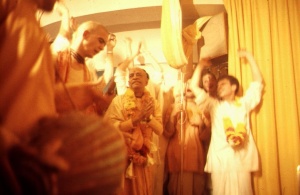SB 3.12.41: Difference between revisions
m (1 revision(s)) |
No edit summary |
||
| Line 1: | Line 1: | ||
{{info | {{info | ||
|speaker=Maitreya | |speaker=Maitreya Ṛṣi | ||
|listener=Vidura | |listener=Vidura | ||
}} | }} | ||
[[Category:Srimad-Bhagavatam - Canto 03 Chapter 12]] | |||
[[Category:Bhagavatam Verses Spoken by Maitreya Rsi - Vanisource|031241]] | |||
<div style="float:left">'''[[Srimad-Bhagavatam]] - [[SB 3|Third Canto]] - [[SB 3.12: Creation of the Kumaras and Others|Chapter 12: Creation of the Kumāras and Others]]'''</div> | |||
<div style="float:right">[[File:Go-previous.png|link=SB 3.12.40]] '''[[SB 3.12.40]] - [[SB 3.12.42]]''' [[File:Go-next.png|link=SB 3.12.42]]</div> | |||
{{RandomImage}} | |||
==== TEXT 41 ==== | ==== TEXT 41 ==== | ||
<div | <div class="verse"> | ||
vidyā dānaṁ tapaḥ satyaṁ | :vidyā dānaṁ tapaḥ satyaṁ | ||
dharmasyeti padāni ca | :dharmasyeti padāni ca | ||
āśramāṁś ca yathā-saṅkhyam | :āśramāṁś ca yathā-saṅkhyam | ||
asṛjat saha vṛttibhiḥ | :asṛjat saha vṛttibhiḥ | ||
</div> | </div> | ||
| Line 16: | Line 22: | ||
==== SYNONYMS ==== | ==== SYNONYMS ==== | ||
<div | <div class="synonyms"> | ||
''vidyā''—education; ''dānam''—charity; ''tapaḥ''—penance; ''satyam''—truth; ''dharmasya''—of religion; ''iti''—thus; ''padāni''—four legs; ''ca''—also; ''āśramān''—orders of life; ''ca''—also; ''yathā''—as they are; ''saṅkhyam''—in number; ''asṛjat''—created; ''saha''—along with; ''vṛttibhiḥ''—by vocations. | |||
</div> | </div> | ||
| Line 23: | Line 29: | ||
==== TRANSLATION ==== | ==== TRANSLATION ==== | ||
<div | <div class="translation"> | ||
Education, charity, penance and truth are said to be the four legs of religion, and to learn this there are four orders of life with different classifications of castes according to vocation. Brahmā created all these in systematic order. | Education, charity, penance and truth are said to be the four legs of religion, and to learn this there are four orders of life with different classifications of castes according to vocation. Brahmā created all these in systematic order. | ||
</div> | </div> | ||
| Line 30: | Line 36: | ||
==== PURPORT ==== | ==== PURPORT ==== | ||
<div | <div class="purport"> | ||
The nucleus of the four social | The nucleus of the four social orders—''brahmacarya'', or student life, ''gṛhastha'', or householder family life, ''vānaprastha'', or retired life for practicing penance, and ''sannyāsa'', or renounced life for preaching the truth—is the four legs of religion. The vocational divisions are the ''brāhmaṇas'', or the intelligent class, the ''kṣatriyas'', or administrative class, the ''vaiśyas'', or mercantile productive class, and the ''śūdras'', or general laborer class who have no specific qualifications. All were systematically planned and created by Brahmā for the regular promotion of self-realization. Student life is meant for acquiring the best education; household family life is meant for gratifying the senses, provided it is performed with a charitable disposition of mind, retirement from household life is meant for penance, for advancement in spiritual life, and renounced life is meant for preaching the Absolute Truth to the people in general. The combined actions of all members of society make the whole situation favorable for the upliftment of the mission of human life. The beginning of this social institution is based on education meant for purifying the animal propensities of the human being. The highest purificatory process is knowledge of the Supreme Personality of Godhead, the purest of the pure. | ||
</div> | </div> | ||
__NOTOC__ | |||
<div style="float:right; clear:both;">[[File:Go-previous.png|link=SB 3.12.40]] '''[[SB 3.12.40]] - [[SB 3.12.42]]''' [[File:Go-next.png|link=SB 3.12.42]]</div> | |||
__NOTOC__ | |||
__NOEDITSECTION__ | |||
Revision as of 10:20, 5 May 2021

A.C. Bhaktivedanta Swami Prabhupada
TEXT 41
- vidyā dānaṁ tapaḥ satyaṁ
- dharmasyeti padāni ca
- āśramāṁś ca yathā-saṅkhyam
- asṛjat saha vṛttibhiḥ
SYNONYMS
vidyā—education; dānam—charity; tapaḥ—penance; satyam—truth; dharmasya—of religion; iti—thus; padāni—four legs; ca—also; āśramān—orders of life; ca—also; yathā—as they are; saṅkhyam—in number; asṛjat—created; saha—along with; vṛttibhiḥ—by vocations.
TRANSLATION
Education, charity, penance and truth are said to be the four legs of religion, and to learn this there are four orders of life with different classifications of castes according to vocation. Brahmā created all these in systematic order.
PURPORT
The nucleus of the four social orders—brahmacarya, or student life, gṛhastha, or householder family life, vānaprastha, or retired life for practicing penance, and sannyāsa, or renounced life for preaching the truth—is the four legs of religion. The vocational divisions are the brāhmaṇas, or the intelligent class, the kṣatriyas, or administrative class, the vaiśyas, or mercantile productive class, and the śūdras, or general laborer class who have no specific qualifications. All were systematically planned and created by Brahmā for the regular promotion of self-realization. Student life is meant for acquiring the best education; household family life is meant for gratifying the senses, provided it is performed with a charitable disposition of mind, retirement from household life is meant for penance, for advancement in spiritual life, and renounced life is meant for preaching the Absolute Truth to the people in general. The combined actions of all members of society make the whole situation favorable for the upliftment of the mission of human life. The beginning of this social institution is based on education meant for purifying the animal propensities of the human being. The highest purificatory process is knowledge of the Supreme Personality of Godhead, the purest of the pure.